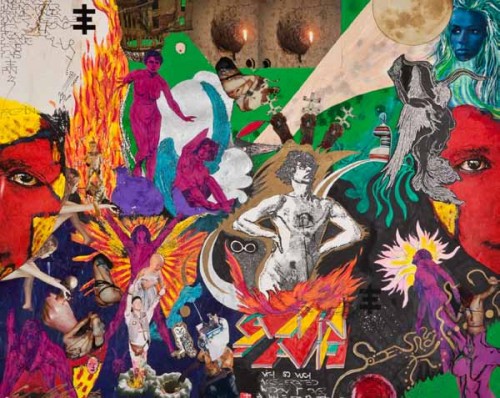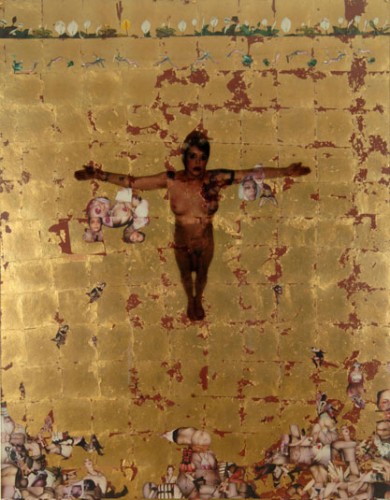
Genesis Breyer P-Orridge: Try to Altar Everything, the latest exhibition at the Rubin Museum of Art, challenges visitors to consider the ways that meaning and identity are constructed in everyday life and across cultures. To that end, the artist employs a variety of techniques and terminology that may be unfamiliar to those who are new to Breyer P-Orridge’s work.
The terms below are used throughout the exhibition and represent some of the central themes of Genesis Breyer P-Orridge’s artistic practice:
Cut-Up

The cut-up technique is an artistic strategy that sought to disrupt conventional aesthetics, meaning, and logic. It was invented as early as the 1920s in conjunction with the Dada “anti-art” movement and popularized by Beat writer William Burroughs in the late 1950s and 1960s. The process involves cutting two texts into small parts or fragments and then rearranging them to create a new, third text that defies authorship and narrative. Renowned writers, including Julio Cortázar, and musicians, including David Bowie, Bob Dylan, Kurt Cobain, and Thom Yorke, have used the cut-up technique to write lyrics. Breyer P-Orridge uses collage in h/er work as a visual manifestation of the cut-up, and s/he and Lady Jaye Breyer P-Orridge applied the concept to their own bodies through their practice of Pandrogeny.
Pandrogeny

Pandrogeny, which stands for Positive Androgeny, is a practice conceived by Genesis and Lady Jaye Breyer P-Orridge to break down the limitations of biological sex and express their unconditional love for each other. Through Pandrogeny the couple sought to create a cosmic union and “conceptually more precise body” through elective surgeries, cross-dressing, and behavioral modifications. On the surface Pandrogeny appears concerned with gender and bears resonance with transgender transitions; in recent years Breyer P-Orridge has been a proud and willing spokesperson for transgender rights and issues. Conceptually, however, the project broadly seeks to dissolve the binaries (including male and female) that shape our culture and to support transformation of the self.
S/he | H/er

In their effort to transcend gender binaries through the practice of Pandrogeny, Genesis and Lady Jaye Breyer P-Orridge adopted a set of creative and inclusive pronouns for self-identification: s/he and h/er. In speech and in writing, Genesis Breyer P-Orridge refers to h/erself as “we,” in reference to the continuation of her union with Lady Jaye (and a play on the British royal plural pronoun), and accepts the gender neutral plural pronouns “they” and “their.”
Sigil

| Cruciform (Sigil Working) Genesis Breyer P-Orridge; 2005 Polaroids, gold leaf, c-print on plexi. Courtesy of the Artists & Invisible-Exports L178.1.1 |
A sigil is a focusing ritual originating in occult traditions that enables practitioners to achieve certain goals. First practitioners define their intention with a statement of image. That image is then transformed into a charged physical tool on which to focusthe mind, especially as the practitioner reaches a sexual climax. For example, for h/er sigils Genesis Breyer P-Orridge creates thematic mixed media collages, but other mediums, including the use of modern technology, are also effective. Ideally the sigil ritual is undertaken at 23:00 on the twenty-third day of the month, as twenty-three is an auspicious number in these traditions.
Take a tour to understand these concepts or learn more about how to personally participate in the exhibition, Genesis Breyer P-Orridge: Try to Altar Everything.

